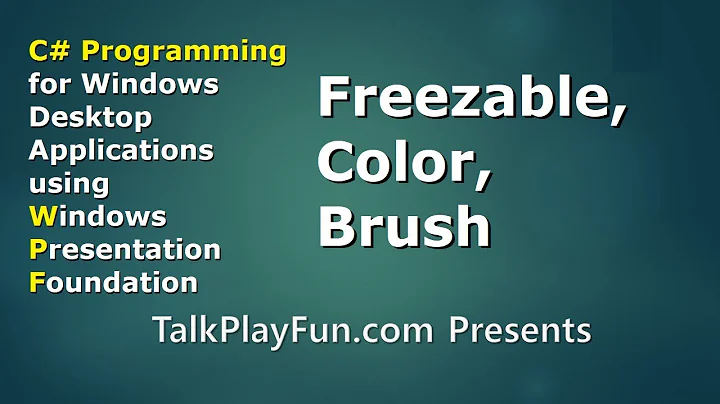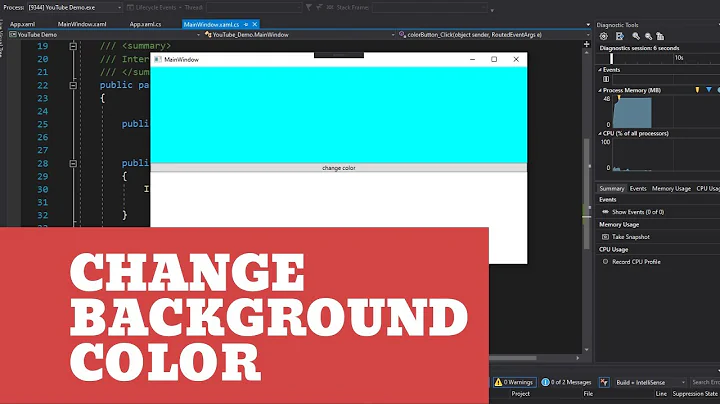WPF C# - Change the brush of a menu's background
Solution 1
I'd suggest using a tool called kaxaml for writing styles. It includes several code snippets, a color picker and a nice way to instantly see what changes in the xaml code does. Here is a full menu style for what you are trying to do. Just change the brush colors at the top to suit to your needs.
<Page
xmlns="http://schemas.microsoft.com/winfx/2006/xaml/presentation"
xmlns:x="http://schemas.microsoft.com/winfx/2006/xaml">
<Page.Resources>
<!--**************************
* STYLE: MenuItem
************************** -->
<SolidColorBrush x:Key="HighlightedBackgroundBrush" Color="#FF797878" />
<SolidColorBrush x:Key="MenuBackgroundBrush" Color="#FF505050" />
<SolidColorBrush x:Key="NormalBorderBrush" Color="#FFFFFFFF" />
<SolidColorBrush x:Key="SolidMenuFontBrush" Color="#FFFFFFFF" />
<SolidColorBrush x:Key="HighlightedText" Color="#FFFFFFFF" />
<Style x:Key="{x:Type Menu}" TargetType="{x:Type Menu}">
<Setter Property="OverridesDefaultStyle" Value="True"/>
<Setter Property="SnapsToDevicePixels" Value="True"/>
<Setter Property="Height" Value="25"/>
<Setter Property="Foreground" Value="{StaticResource SolidMenuFontBrush}"/>
<Setter Property="Template">
<Setter.Value>
<ControlTemplate TargetType="{x:Type Menu}">
<Border
Background="{StaticResource MenuBackgroundBrush}"
BorderBrush="{StaticResource MenuBackgroundBrush}"
BorderThickness="1">
<StackPanel ClipToBounds="True" Orientation="Horizontal" IsItemsHost="True"/>
</Border>
</ControlTemplate>
</Setter.Value>
</Setter>
</Style>
<Style x:Key="{x:Type MenuItem}" TargetType="{x:Type MenuItem}">
<Setter Property="Template">
<Setter.Value>
<ControlTemplate TargetType="{x:Type MenuItem}">
<Border x:Name="Border"
Background="{TemplateBinding Background}"
BorderBrush="{TemplateBinding BorderBrush}"
BorderThickness="1">
<Grid>
<Grid.ColumnDefinitions>
<ColumnDefinition x:Name="Col0" MinWidth="17" Width="Auto" SharedSizeGroup="MenuItemIconColumnGroup"/>
<ColumnDefinition Width="Auto" SharedSizeGroup="MenuTextColumnGroup"/>
<ColumnDefinition Width="Auto" SharedSizeGroup="MenuItemIGTColumnGroup"/>
<ColumnDefinition x:Name="Col3" Width="14"/>
</Grid.ColumnDefinitions>
<!-- ContentPresenter to show an Icon if needed -->
<ContentPresenter Grid.Column="0" Margin="4,0,6,0" x:Name="Icon" VerticalAlignment="Center" ContentSource="Icon"/>
<!-- Glyph is a checkmark if needed for a checkable menu -->
<Grid Grid.Column="0" Visibility="Hidden" Margin="4,0,6,0" x:Name="GlyphPanel" VerticalAlignment="Center">
<Path x:Name="GlyphPanelpath" VerticalAlignment="Center" Fill="{TemplateBinding Foreground}" Data="M0,2 L0,4.8 L2.5,7.4 L7.1,2.8 L7.1,0 L2.5,4.6 z" FlowDirection="LeftToRight"/>
</Grid>
<!-- Content for the menu text etc -->
<ContentPresenter Grid.Column="1"
Margin="{TemplateBinding Padding}"
x:Name="HeaderHost"
RecognizesAccessKey="True"
ContentSource="Header"/>
<!-- Content for the menu IGT -->
<ContentPresenter Grid.Column="2"
Margin="8,1,8,1"
x:Name="IGTHost"
ContentSource="InputGestureText"
VerticalAlignment="Center"/>
<!-- Arrow drawn path which points to the next level of the menu -->
<Grid Grid.Column="3" Margin="4,0,6,0" x:Name="ArrowPanel" VerticalAlignment="Center">
<Path x:Name="ArrowPanelPath" HorizontalAlignment="Right" VerticalAlignment="Center" Fill="{TemplateBinding Foreground}" Data="M0,0 L0,8 L4,4 z"/>
</Grid>
<!-- The Popup is the body of the menu which expands down or across depending on the level of the item -->
<Popup IsOpen="{Binding Path=IsSubmenuOpen, RelativeSource={RelativeSource TemplatedParent}}" Placement="Right" x:Name="SubMenuPopup" Focusable="false" PopupAnimation="{DynamicResource {x:Static SystemParameters.MenuPopupAnimationKey}}">
<Border x:Name="SubMenuBorder" BorderBrush="{Binding Path=Foreground, RelativeSource={RelativeSource AncestorType={x:Type Menu}}}" BorderThickness="1" Padding="2,2,2,2">
<Grid x:Name="SubMenu" Grid.IsSharedSizeScope="True">
<!-- StackPanel holds children of the menu. This is set by IsItemsHost=True -->
<StackPanel IsItemsHost="True" KeyboardNavigation.DirectionalNavigation="Cycle"/>
</Grid>
</Border>
</Popup>
</Grid>
</Border>
<!-- These triggers re-configure the four arrangements of MenuItem to show different levels of menu via Role -->
<ControlTemplate.Triggers>
<!-- Role = TopLevelHeader : this is the root menu item in a menu; the Popup expands down -->
<Trigger Property="Role" Value="TopLevelHeader">
<Setter Property="Padding" Value="6,1,6,1"/>
<Setter Property="Placement" Value="Bottom" TargetName="SubMenuPopup"/>
<Setter Property="MinWidth" Value="0" TargetName="Col0"/>
<Setter Property="Width" Value="Auto" TargetName="Col3"/>
<Setter Property="Visibility" Value="Collapsed" TargetName="Icon"/>
<Setter Property="Visibility" Value="Collapsed" TargetName="GlyphPanel"/>
<Setter Property="Visibility" Value="Collapsed" TargetName="IGTHost"/>
<Setter Property="Visibility" Value="Collapsed" TargetName="ArrowPanel"/>
</Trigger>
<!-- Role = TopLevelItem : this is a child menu item from the top level without any child items-->
<Trigger Property="Role" Value="TopLevelItem">
<Setter Property="Padding" Value="6,1,6,1"/>
<Setter Property="Visibility" Value="Collapsed" TargetName="ArrowPanel"/>
</Trigger>
<!-- Role = SubMenuHeader : this is a child menu item which does not have children -->
<Trigger Property="Role" Value="SubmenuHeader">
<Setter Property="DockPanel.Dock" Value="Top"/>
<Setter Property="Padding" Value="0,2,0,2"/>
</Trigger>
<!-- Role = SubMenuItem : this is a child menu item which has children-->
<Trigger Property="Role" Value="SubmenuItem">
<Setter Property="DockPanel.Dock" Value="Top"/>
<Setter Property="Padding" Value="0,2,0,2"/>
<Setter Property="Visibility" Value="Collapsed" TargetName="ArrowPanel"/>
</Trigger>
<Trigger Property="IsSuspendingPopupAnimation" Value="true">
<Setter Property="PopupAnimation" Value="None" TargetName="SubMenuPopup"/>
</Trigger>
<!-- If no Icon is present the we collapse the Icon Content -->
<Trigger Property="Icon" Value="{x:Null}">
<Setter Property="Visibility" Value="Collapsed" TargetName="Icon"/>
</Trigger>
<!-- The GlyphPanel contains the CheckMark -->
<Trigger Property="IsChecked" Value="true">
<Setter Property="Visibility" Value="Visible" TargetName="GlyphPanel"/>
<Setter Property="Visibility" Value="Collapsed" TargetName="Icon"/>
</Trigger>
<!-- Using the system colors for the Menu Highlight and IsEnabled-->
<Trigger Property="IsHighlighted" Value="true">
<Setter Property="Background" Value="{StaticResource HighlightedBackgroundBrush}" TargetName="Border"/>
<Setter Property="Foreground" Value="{StaticResource HighlightedText}"/>
<Setter Property="BorderBrush" Value="{StaticResource NormalBorderBrush}" TargetName="Border"/>
</Trigger>
<Trigger Property="IsHighlighted" Value="false">
<Setter Property="Background" Value="{StaticResource MenuBackgroundBrush}" TargetName="Border"/>
<Setter Property="Foreground" Value="{StaticResource SolidMenuFontBrush}"/>
<Setter Property="BorderBrush" Value="{StaticResource MenuBackgroundBrush}" TargetName="Border"/>
</Trigger>
<Trigger Property="IsEnabled" Value="false">
<Setter Property="Foreground" Value="LightGray"/>
</Trigger>
</ControlTemplate.Triggers>
</ControlTemplate>
</Setter.Value>
</Setter>
</Style>
</Page.Resources>
<Grid x:Name="mainGrid"
Background="#FF252525">
<Menu x:Name="mainMenu"
Grid.ColumnSpan="2"
VerticalAlignment="Top">
<MenuItem x:Name="fileMenu"
Header="File">
<MenuItem x:Name="fileOpenMenuItem"
Header="Open..." />
<MenuItem x:Name="fileSaveMenuItem"
Header="Save" />
<MenuItem x:Name="fileSaveAsMenuItem"
Background="{DynamicResource menuItemBrush}"
Header="Save As..." />
</MenuItem>
</Menu>
</Grid>
</Page>
Solution 2
You can't do it without overriding the template for the menu item. Deep inside the template is a control called "Part_Popup". You need to change it's background color.
Related videos on Youtube
user62998
Updated on August 13, 2020Comments
-
user62998 over 3 years
Does anyone know how to change the brush for a menu's background? This sounds simple, but I don't see any obvious way to do this. You'd think that the Background property would change it, but it doesn't.
Here's what my menu looks like (notice the default white background):
Example Code:
<Window x:Class="WpfApplication1.Window1" xmlns="http://schemas.microsoft.com/winfx/2006/xaml/presentation" xmlns:x="http://schemas.microsoft.com/winfx/2006/xaml" Title="Window1" Height="300" Width="300"> <Window.Resources> <SolidColorBrush x:Key="menuItemBrush" Color="#FF505050" /> </Window.Resources> <Grid x:Name="mainGrid" Background="#FF252525"> <Menu x:Name="mainMenu" Background="{DynamicResource menuItemBrush}" Grid.ColumnSpan="2" VerticalAlignment="Top"> <MenuItem x:Name="fileMenu" Background="{DynamicResource menuItemBrush}" Foreground="White" Header="File"> <MenuItem x:Name="fileOpenMenuItem" Background="{DynamicResource menuItemBrush}" Foreground="White" Header="Open..." /> <MenuItem x:Name="fileSaveMenuItem" Background="{DynamicResource menuItemBrush}" Foreground="White" Header="Save" /> <MenuItem x:Name="fileSaveAsMenuItem" Background="{DynamicResource menuItemBrush}" Foreground="White" Header="Save As..." /> <Separator Style="{DynamicResource menuItemSeperator}" /> <MenuItem x:Name="fileExitMenuItem" Background="{DynamicResource menuItemBrush}" Foreground="White" Header="Exit" /> </MenuItem> </Menu> </Grid>-
DK. almost 13 yearsThis article looks useful. It shows how to customize item control templates (as opposed to styles in Nate's answer): blogs.microsoft.co.il/blogs/pavely/archive/2010/10/01/…
-
 Tara almost 10 yearsWhy didn't you upload the image to stackoverflow? It's unavailable now.
Tara almost 10 yearsWhy didn't you upload the image to stackoverflow? It's unavailable now.
-
-
user62998 about 15 yearsHow would I go about accessing this property? It would be nice if I could just override that one property. I tried doing it through C# code using something like "this.FindResource("Part_Popup)", but it can't find the resource.
-
 Micah about 15 yearsTry myMenu.Template.FindName("Part_Popup", this);
Micah about 15 yearsTry myMenu.Template.FindName("Part_Popup", this); -
user62998 about 15 yearsI get an InvaildOperationException: This operation is valid only on elements that have this template applied. I tried replacing "this" with the menu and that doesn't work either.
-
NoOne over 11 yearsIs there a license of some kind to this and the styles that come with kaxaml ?
-
Nikita B about 7 years@NoOne, every code snippet posted on SE implicitly uses MIT license. Kaxaml also uses MIT.







